1996 CHEVROLET BLAZER light
[x] Cancel search: lightPage 79 of 392

Downloaded from www.Manualslib.com manuals search engine If you skip more than onc ,ear when you
downshift, you could lose control of your vehicle. And you could injure yourself or others. Don’t shift
down more than one gear when you downshift.
If your vehicle has four-wheel drive and is equipped
with a manual transmission, disregard the shift light
when the transfer case is in
4LO.
Locking Rear Axle
If you have this reature, your rear axle can give you
additional traction
on snow, mud, ice, sand or gravel. It
works like a standard axle most
of the time, but when
one of the rear wheels has no traction and the other does,
the locking feature will allow the wheel with traction to
move the vehicle.
All-Wheel Drive (Option)
If your vehicle has all-wheel drive, your engine’s
driving power is
sent to all four wheels for extra
traction. This
is like four-wheel drive, but there is no
lever or switch to engage or disengage the front
axle.
It is fully automatic and adjusts itself as needed for
road conditions.
Four-wheel Drive (Option)
If your vehicle has four-wheel drive, you can send your
engine’s driving power to all four wheels for extra
traction.
To shift out of two-wheel drive and into
four-wheel drive, move the transfer case shift lever
to
4HI or 4LO. You should use 2HI for most normal
driving conditions.
NOTICE:
Driving in the 4HI or 4LO positions for a long
time on dry or wet pavement could shorten the life of your vehicle’s drivetrain.
2-21
Page 80 of 392
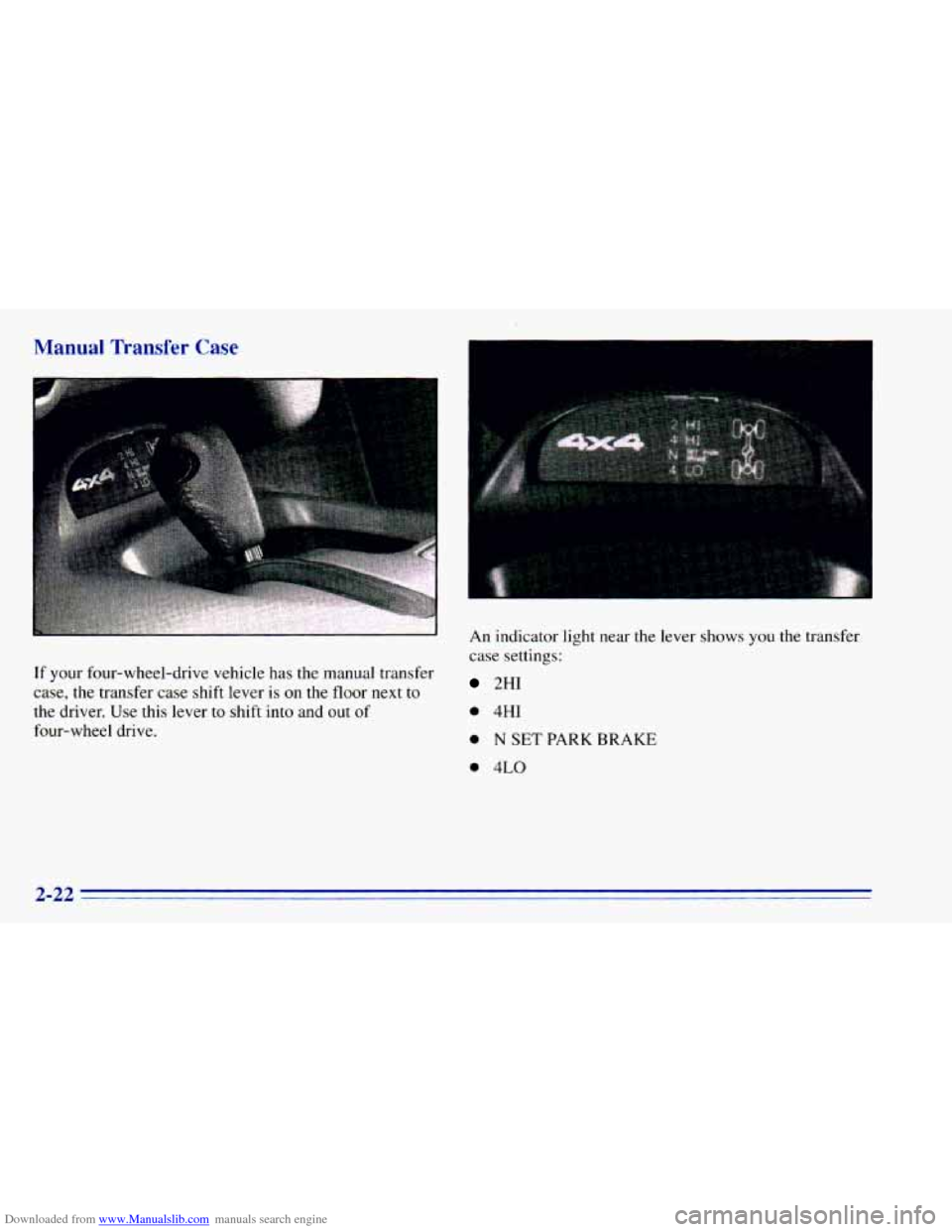
Downloaded from www.Manualslib.com manuals search engine Manual Transfer Case
If your four-wheel-drive vehicle has the manual transfer
case,
the transfer case shift lever is on the floor next to
the driver. Use this lever to shift into and out of
four-wheel drive. An
indicator light near
the lever shows you the transfer
case settings:
2HI
0 4HI
0 N SET PARK BRAKE
0 4LO
2-22
Page 81 of 392
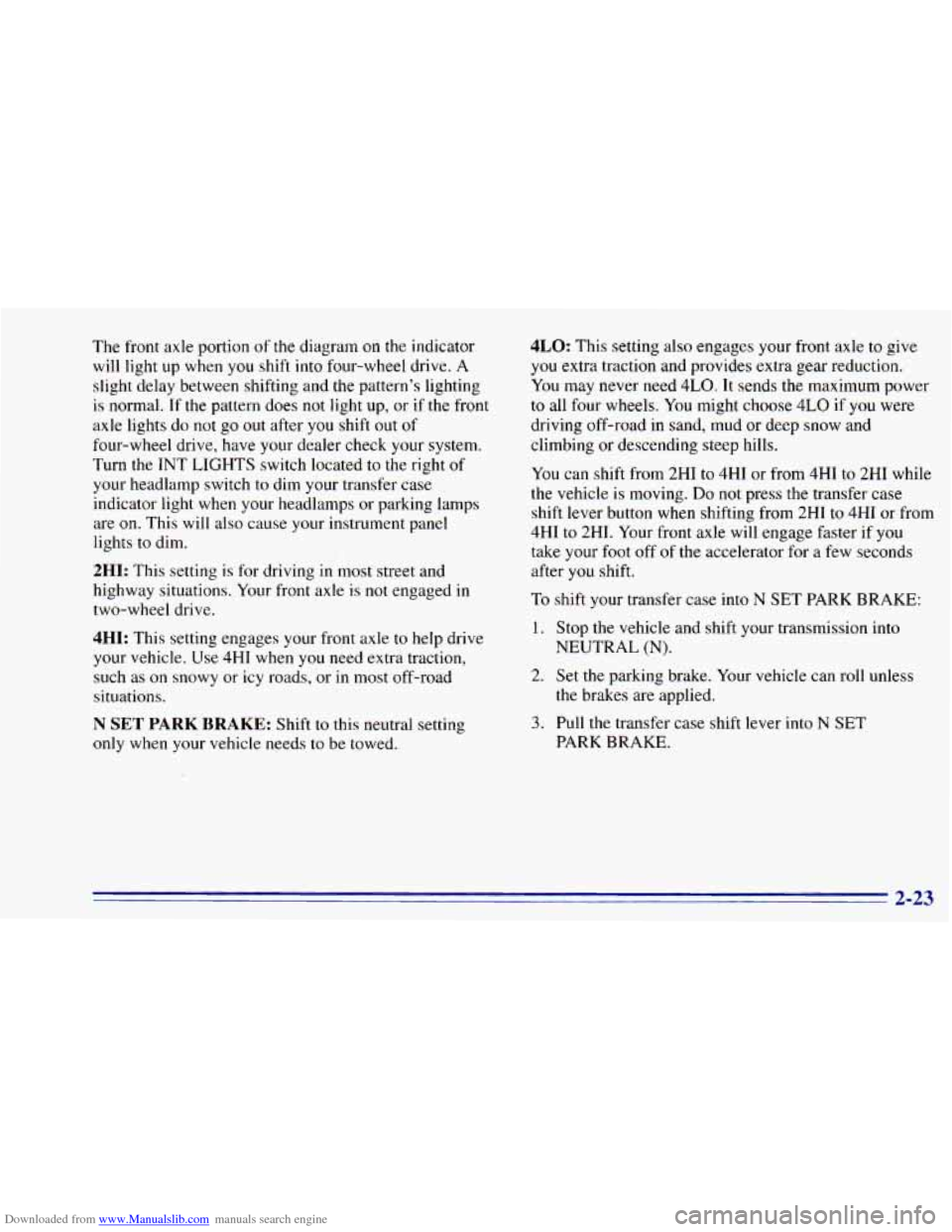
Downloaded from www.Manualslib.com manuals search engine The front axle portion of the diagram on the indicator
will light up when
you shift into four-wheel drive. A
slight delay between shifting and the pattern’s lighting
is normal. If the pattern does
not light up, or if the front
axle lights do not go out after
you shift out of
four-wheel drive, have your dealer check your system.
Turn the INT LIGHTS switch located to the right of
your headlamp switch to dim your transfer case
indicator light when your headlamps or parking lamps
are
on. This will also cause your instrument panel
lights
to dim.
2HI: This setting is for driving in most street and
highway situations. Your front axle is
not engaged in
two-wheel drive.
4HI: This setting engages your front axle to help drive
your vehicle. Use 4HI when you need extra traction,
such as on snowy or icy roads, or in most off-road
situations.
N SET PARK BRAKE: Shift to this neutral setting
only when your vehicle needs
to be towed.
4LO: This setting also engages your front axle to give
you extra traction and provides extra gear reduction.
You may never need 4LO. It sends the maximum power
to all four wheels. You might choose 4LO if you were
driving off-road in sand, mud or deep snow and
climbing
or descending steep hills.
You can shift from 2HI to 4HI or from 4HI to 2HI while
the vehicle
is moving. Do not press the transfer case
shift lever button when shifting from 2HI to 4HI or from
4HI
to 2HI. Your front axle will engage faster if you
take your foot off of the accelerator for a few seconds
after
you shift.
To shift your transfer case into N SET PARK BRAKE:
1. Stop the vehicle and shift your transmission into
NEUTRAL
(N).
2. Set the parking brake. Your vehicle can roll unless
3. Pull the transfer case shift lever into N SET
the brakes are applied.
PARK BRAKE.
2-23
Page 83 of 392

Downloaded from www.Manualslib.com manuals search engine 4LO: This setting also engages your front axle to give
you extra traction. You may never need 4LO. It sends
the maximum power to all four wheels. You might
choose 4LO
if you were driving off-road in sand, mud
or deep snow and climbing or descending steep hills.
Indicator lights
in the switches show you which setting
you are in. The indicator lights will come on briefly when
you turn
on the ignition and one will stay on. If the lights
do not come on, you should take your vehicle
in for
service. An indicator light will flash while shifting.
It will
remain illuminated when the shift is completed.
Shifting from 2HI to 4HI'
Press and release the 4HI switch. This can be done at
any speed, and the front axle will lock automatically.
Shifting from 4HI to 2HI
Press and release the 2HI switch. This can be done at
any speed, and the front axle will unlock automatically.
Shifting from 2HI or I1 to 4LO
To shift from tHI or 4HI to 4L0, the vehicle must be
stopped or moving less than
3 mph (4.8 km/h) with the
transmission
in NEUTRAL (N) in vehicles equipped with an
automatic transmission or the clutch pedal
engaged in vehicles equipped with a manual
transmission. The preferred method for shifting into
4LO is
to have your vehicle moving 1 to 2 mph
(1.6
to 3.2 km/h). Press and release the 4LO switch.
You must wait for the 4LO indicator light to stop
flashing and remain illuminated before shifting your
transmission
into gear or releasing the clutch pedal.
If the 4LO switch is pressed when your vehicle is in
gear and/or moving, the 4LO indicator light will flash
for
30 seconds and not complete the shift unless your
vehicle is moving slower than
3 mph (4.8 km/h) and
the transmission is in NEUTRAL (N) or the clutch
pedal engaged.
On automatic transmission equipped vehicles, if your
transfer case does not shift into 4L0, your transmission
indicator switch may require adjustment. With your
transmission
in NEUTRAL (N), press and release the
4LO switch. While the 4LO indicator light is flashing,
shift your transmission into PARK (P). Wait until the
4LO indicator light remains illuminated before shifting
your transmission
into gear. This will get you into 4L0,
but you should take your vehicle
in for service to restore
normal operation.
2-25
Page 84 of 392
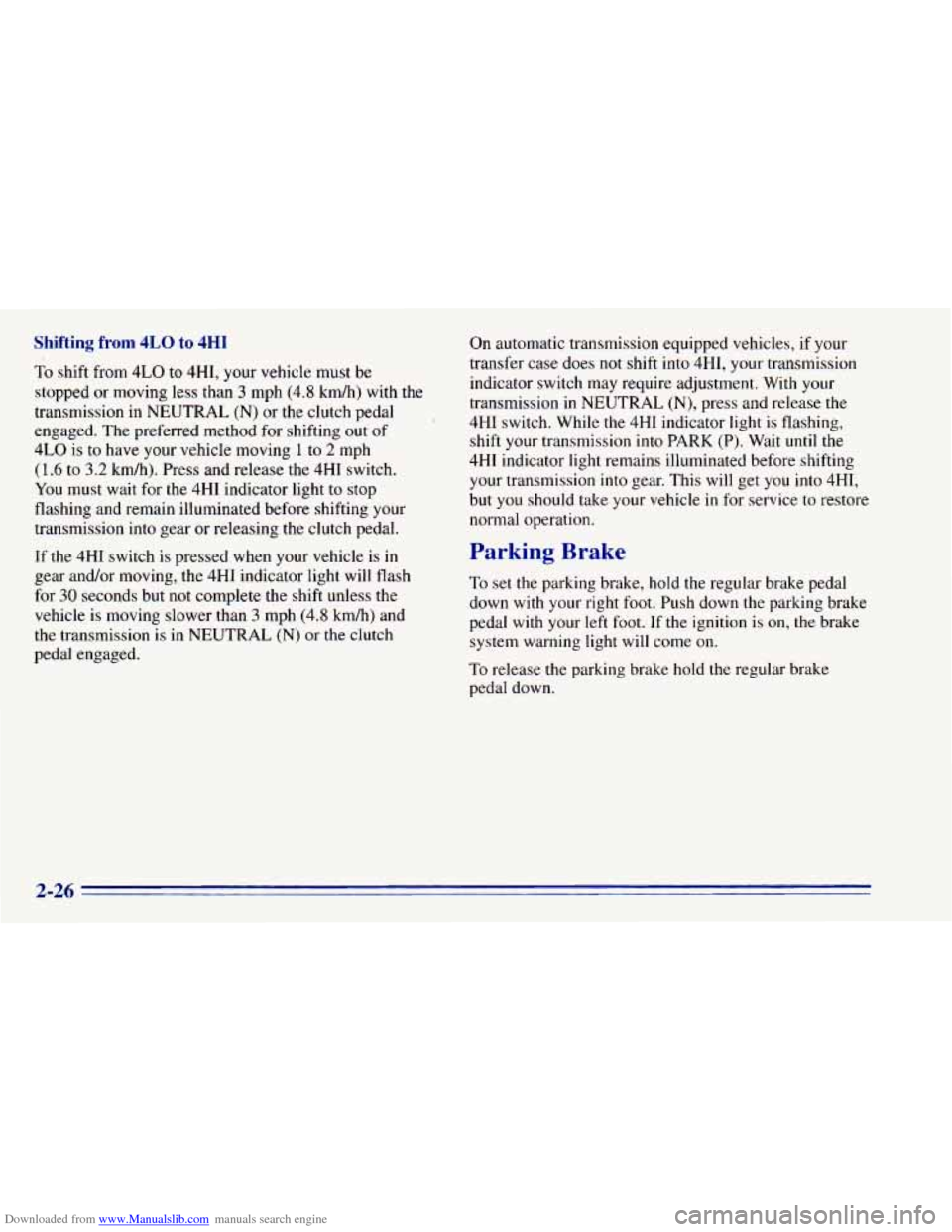
Downloaded from www.Manualslib.com manuals search engine Shifting from 4LO to 4HI
To shift from 4LO to 4H1, your vehicle must be
stopped or moving
less than 3 mph (4.8 km/h) with the
transmission
in NEUTRAL (N) or the clutch pedal
engaged. The preferred method for shifting out
of
4LO is to have your vehicle moving 1 to 2 mph
(1.6 to 3.2 km/h). Press and release the 4HI switch.
You must wait for
the 4HI indicator light to stop
flashing and remain illuminated before shifting your
transmission into gear or releasing the clutch pedal.
If the 4HI switch is pressed when your vehicle is in
gear and/or moving, the 4HI indicator light will flash
for
30 seconds but not complete the shift unless the
vehicle is moving slower than
3 mph (4.8 km/h) and
the transmission is in NEUTRAL
(N) or the clutch
pedal engaged. On automatic transmission equipped vehicles,
if your
transfer case does not shift into 4H1, your transmission
indicator switch may require adjustment. With your
transmission in NEUTRAL
(N), press and release the
4HI switch. While the 4HI indicator light is flashing,
shift your transmission into PARK
(P). Wait until the
4HI indicator light remains illuminated before shifting
your transmission into gear. This will get you into 4H1,
but you should take your vehicle
in for service to restore
normal operation.
Parking Brake
To set the parking brake, hold the regular brake pedal
down with your right foot. Push down the parking brake
pedal with your left foot. If
the ignition is on, the brake
system warning light will come on.
To release
the parking brake hold the regular brake
pedal down.
2-26
Page 92 of 392

Downloaded from www.Manualslib.com manuals search engine Lockout Switch
Press the side of the switch with the down arrow to
lower the window.
Pres the side of the switch with the up arrow to raise
the window.
Express-Down Window
The driver’s window switch has an express-down
feature that allows
you to lower it without holding the
window switch. Hold the driver’s window switch down
for more than a
1/2 second to activate the express-down
feature. Lightly tap the switch to open
the window
slightly. The express-down feature can be interrupted at
any time by pressing the up arrow end
of the switch.
- , .. .. .., - . ...
Four-door vehicles have a lockout feature to prevent
passengers from operating power windows. It is
located
on the driver’s door. Press LOCK to activate
this feature. Press
NORM and the windows return to
normal operation.
2-34
Page 95 of 392
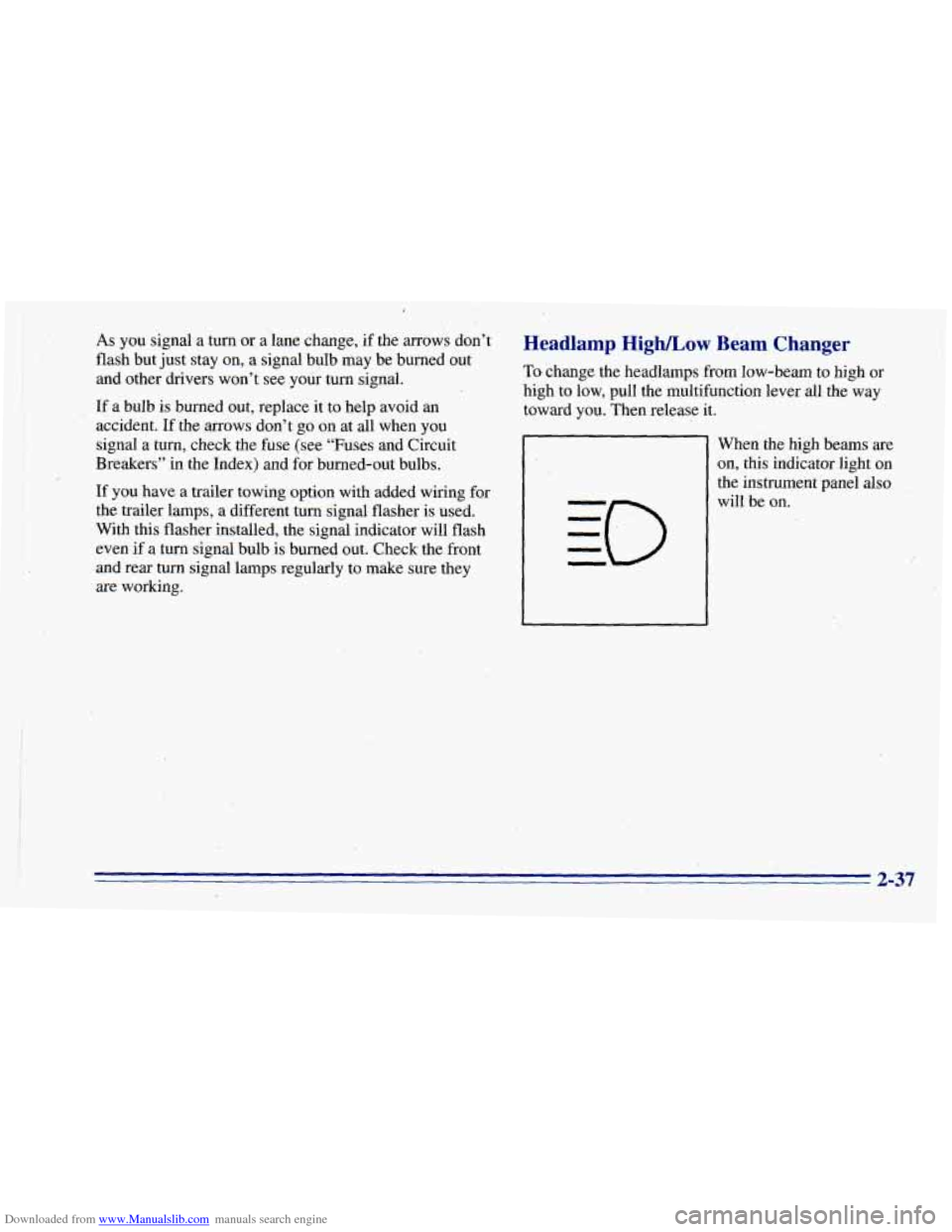
Downloaded from www.Manualslib.com manuals search engine ,
As you signal a turn or a’lane change, if the arrows don’t
flash but just stay on, a signal bulb may be burned out
and other drivers won’t see your turn signal.
accident. If the arrows
don’t go on at all when you
signal a turn, check the fuse (see “Fuses and Circuit
Breakers” in the Index) and for burned-out bulbs.
If you have a trailer towing option with added wiring for
the trailer lamps, a different turn signal flasher is used.
With this flasher installed, the signal indicator will flash
even if a turn signal bulb is burned out. Check the front
and rear turn signal lamps regularly
to make sure they
are working.
,- If a bulb is burned out, replace it to help avoid an
Headlamp High/Low Beam Changer
Toxhange the headlamps from low-beam to high or
high to low, pull the multifunction lever all the
way
toward you. Then release it.
When the high beams are
on, this indicator light on
the instrument panel also
will be
on.
2-37
Page 96 of 392
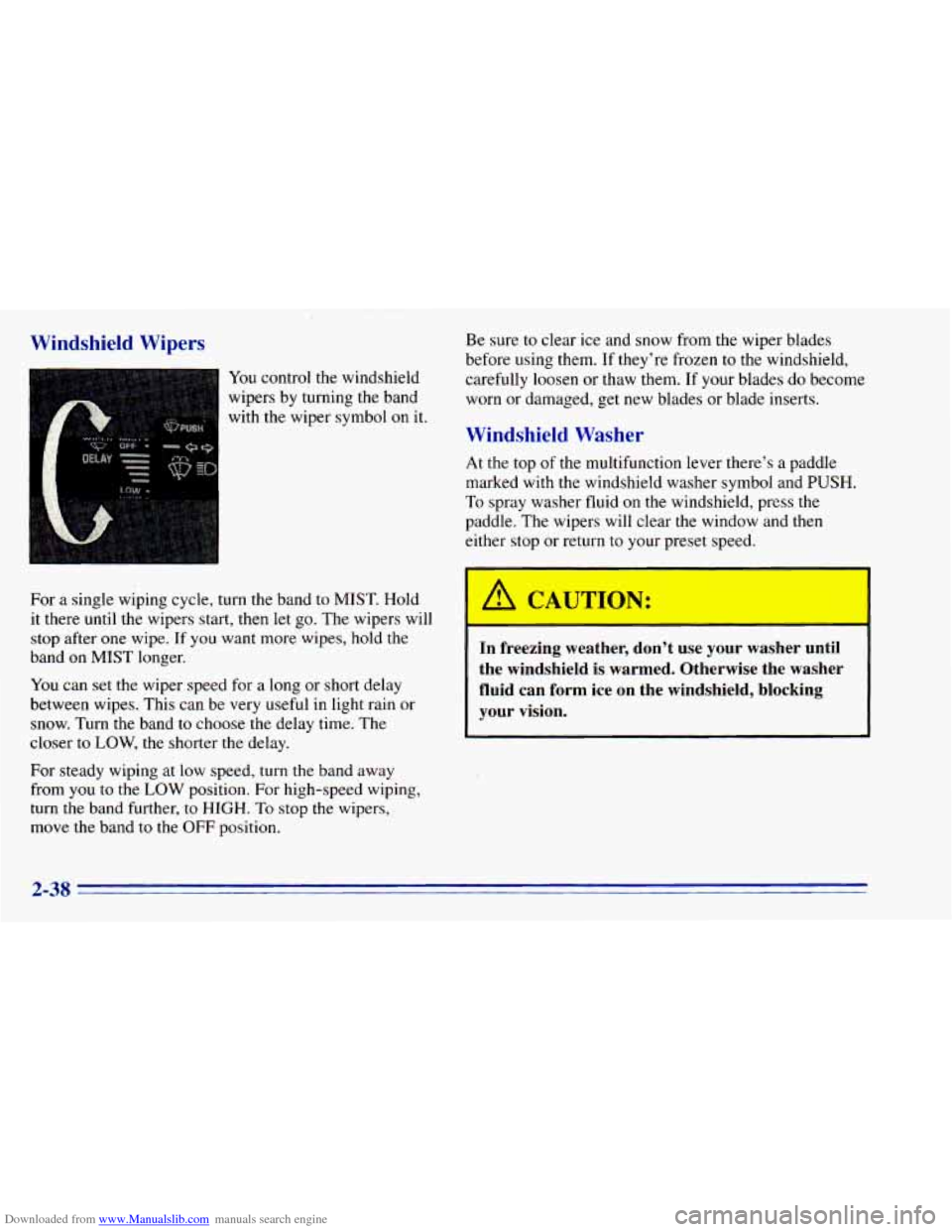
Downloaded from www.Manualslib.com manuals search engine Windshield Wipers
You control the windshield
wipers by turning the band
with the wiper symbol
on it.
For a single wiping cycle, turn the band to MIST. Hold
it there until the wipers start, then let
go. The wipers will
stop after one wipe. If you want more wipes, hold the
band on MIST longer.
You can set the wiper speed for a long or short delay
between wipes. This can be very useful in light rain or
snow. Turn
the band to choose the delay time. The
closer to
LOW, the shorter the delay.
For steady wiping at low speed, turn the band away
from
you to the L,OW position. For high-speed wiping,
turn the band further, to HIGH.
To stop the wipers,
move the band to the
OFF position. Be sure
to clear
ice and snow from the wiper blades
before using
them. If they’re frozen to the windshield,
carefully loosen
or thaw them. If your blades do become
worn or damaged, get new blades or blade inserts.
Windshield Washer
At the top of the multifunction lever there’s a paddle
marked
with the windshield washer symbol and PUSH.
To spray washer fluid on the windshield, press the
paddle. The wipers will clear the window and then
either stop or return
to your preset speed.
In freezing weather, don’t use your washer until
the windshield
is warmed. Otherwise the washer
fluid can form ice on the windshield, blocking
your vision.
2-38